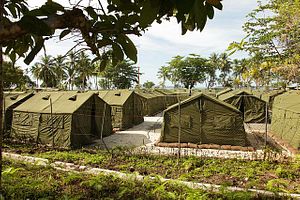The Australian government continues to face difficulties with the legalities — and the conduct — of the offshore detention centers it uses to detain those who have sought asylum in Australia via maritime routes. Earlier this week the Australian government decided to settle a class action suit brought by a group of refugees and asylum seekers for false imprisonment and negligence. A compensation package of $70 million (USD $55.9 million) has been awarded to around 1,300 current and former detainees of the Manus Island detention center in Papua New Guinea (PNG), one of Australia’s two offshore detention centers (the other is on Nauru)
Had the class action suit gone to trial, the court would have been presented with allegations of physical and sexual abuse within facility, as well as inadequate medical treatment for detainees, failure to provide basic human necessities such as clean water, hygienic bathroom facilities, and appropriate shelter from natural elements such and heat, rain, and insects. There have also been a number of preventable deaths within the facility.
Most of these allegations have been fairly well publicized within Australia and internationally, though the government has shown little remorse or even embarrassment. Instead, there has been an attempt to claim that as the Manus Island facility is located in PNG, then it is the PNG government which is responsible for care of detainees under the relevant United Nations conventions on refugees and asylum seekers. This claim has been made despite the fact that PNG has been hosting the facility at Australia’s (financially incentivized) request. Australia is the sole funder of the facility and maintains effective control over the facility’s operations.
It seems likely that the legality of whether Australia or PNG is responsible for the duty of care within the Manus Island facility is not something that the Australian government wanted tested in a court. The Australian government looks to have opted for quick settlement in order to avoid in-depth scrutiny of the legal implications of its entire offshore detention operation.
While this has been a victory of sorts for those asylum seekers and refugees still being held on Manus Island, there is still a lack of resolution to their situation. In April 2016 the PNG Supreme Court ruled that the detention facility on Manus Island was unconstitutional and should be closed as quickly as possible, with arrangements made to relocate the detainees. This has yet to occur, although the Australian government has claimed that the facility will be closed on October 31.
While those who have been awarded refugee status are able to stay in PNG, the country remains an inappropriate place for resettlement, lacking the resources and social stability to facilitate any path towards normalcy for these refugees. The prospect is an unfair burden for both the refugees and PNG alike.
Around 700 hundred of the current detainees are eligible (subject to “extreme vetting”) to be relocated to the United States in the refugee swap deal that Australia struck with President Barack Obama, and while President Donald Trump has begrudgingly accepted. However, in July the United States reached its annual cap of 50,000 refugees, and it remains unclear whether the United States will add these additional 700 to their quota, or indeed whether they will pass the country’s vetting process. It seems unlikely that these issues will be resolved before the scheduled closing date of October 31. Despite the payout these detainees will receive, their lives will remain in limbo
Australia’s policy of illegal immigration deterrence has not only rested on the idea that those seeking asylum would never be settled in Australia, but that the inhospitable conditions on Manus Island (and Nauru) would act as a further deterrent to others attempting to seek asylum in Australia via boats. The cruelty of the system has been part of its design. The Australian government may see this $70 million settlement for the suffering they have inflicted as simply the cost of doing business.
Yet this settlement might not provide the quick disposal of this issue that the Australian government may be hoping for. The settlement arrangement potentially sets a precedent for similar claims to be made by detainees on Nauru. In August 2016, The Guardian revealed a number of documents that detailed a range of similar abuses occurring within Australia’s other outsourced detention facility on the island nation.
The policies Australia has created towards asylum seekers since the initial “Pacific Solution” was created in 2001 has never been about creating a solution for those seeking asylum, but simply an attempt to push the issue away from Australia. Therefore, their “solutions” have never addressed the actual problem, only Australia’s desire to avoid it. Despite Australia’s numerous attempts to dump its international responsibilities toward asylum seekers and refugees onto other countries (PNG, Nauru, Indonesia, Malaysia, Cambodia, and the United States), the issues continue to float back towards Australia shores.

































